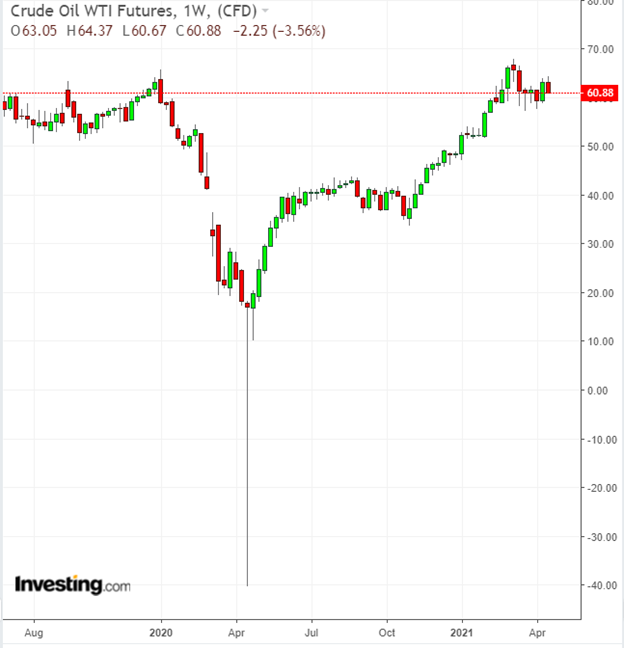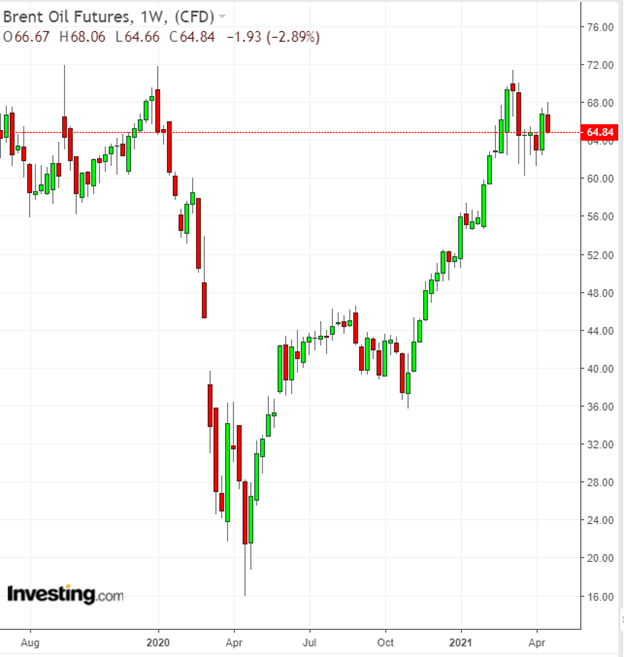This oil market is different from anything traders have experienced before, in part because the stabilizing forces and traditional indicators have been turned on their heads.
Here is a look at what some banks, agencies and economists see for the future of oil this year. Below you will also find a look at how OPEC+ might affect the market, with its next meeting scheduled for a week from yesterday. (Note, OPEC+ may or may not hold a meeting next week on Apr. 28—the decision is still being made).
Diverse Opinions On Prices, Supply And Demand
Oil prices have been relatively stable in April, with WTI hovering close to the $60 per barrel mark and Brent a few dollars more. Some analysts, like those at Goldman Sachs and Citigroup, think that prices will rise to $80 per barrel or near that this summer. Indeed, they see demand for petroleum growing to record levels and pandemic restrictions relaxing in Q3.
Others are more skeptical as coronavirus cases in India are now rising and European countries are looking to place more restrictions on travel.

The U.S. Energy Information Administration (EIA), in its latest Short Term Oil Outlook, sees oil supply and demand converging in Q3 this year and then consumption slightly outpacing supply in Q4. Nevertheless, the EIA’s forecast sees Brent only averaging $61 per barrel in the second half of the year, which would actually be a decrease from the current Brent price, which is around $65 per barrel.

An interesting view of this forecast was raised by the Chief Economist of the American Petroleum Institute (API), Dr. Dean Foreman, on the Energy Week podcast earlier this week. (Disclaimer: I am the co-host of this podcast). He explained that the EIA forecast includes the assumption that U.S. production will increase by 900,000 bpd to meet growing demand in 2021.
However, based on discussions with U.S. oil producers and assessments of their plans, it seems that U.S. output is unlikely to increase this much and that the U.S. will more likely only see a production increase of half that amount.
If this is the case, and demand accelerates as expected, then prices would rise in the second half of the year, in contrast to what the EIA forecasts. However, much depends on the responsiveness of OPEC+. By failing to increase production, the U.S. will have essentially opened the door for OPEC+ to increase its output by more than it is currently planning.
OPEC+: Reactive Rather Than Proactive
OPEC+ is taking a “wait and see” approach. Right now, it plans to increase oil production gradually in May, June and July with the caveat that it will “tweak” production higher or lower at its now monthly meetings depending on market signals. This might seem like a measured approach, but OPEC+’s own reactionary strategy could be the very thing that triggers a price jump.
This year, instead of setting production quotas for 6 months at a time, OPEC+ has moved to a monthly meeting schedule where it sets production rates 1, 2 or at most, 3 months at a time. Saudi Arabia has also announced “surprise” unilateral cuts that have impacted the market.
OPEC+ is trying to meet each month while still providing enough time for the oil companies to understand the policy and determine their OSPs (official selling prices) for the next month. And OPEC+ is meeting regularly so that it and its members will be able to react to changes in the market.
However, as a result of the increased frequency of the OPEC+ meetings, no one—including the oil companies, their customers and the oil traders—knows what to expect from OPEC+. At the same time, OPEC+ has largely become a market reactor instead of a market setter.
Challenges Forecasting The Next Few Months
Fourteen months ago, oil traders looked generally at certain indicators to forecast prices. They looked at production trends, OPEC+ policy, the general health of economies (to determine future demand), and seasonal issues related to travel, refining, electricity usage (where oil is burned for electricity), etc.
Today, the information traders need has been turned on its head. Production trends in the U.S. are hard to deduce, in part because producers are wary of changes brought on by new government leadership.
OPEC+ has become reactionary, changing policy on a monthly basis instead of every six months. Economic health is no longer organic, but now tied directly to the imposition and relaxation of restrictions and lockdowns imposed by governments.
That is why we see so many diverging forecasts and forecasts changing monthly. Nothing is what it was at the start of 2020.
